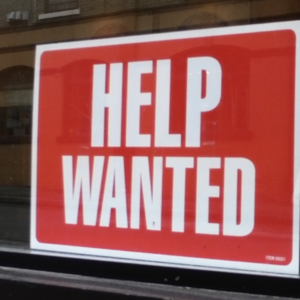This article originally appeared on the Josiah Bartlett Center website.
As a few lawmakers engaged in a publicity stunt last Saturday to press for a state-imposed $15 minimum wage, New Hampshire employers were raising wages and offering cash incentives in desperate efforts to attract workers.
A Portsmouth restaurant is hiring line cooks for $22 an hour, with a $500 signing bonus. A Salem cafe is offering up to $22 an hour and a $600 signing bonus.
The pandemic has worsened New Hampshire’s already challenging labor shortage as thousands have dropped out of the workforce for a variety of COVID-related reasons. Employers have responded by raising pay.
Average hourly earnings in New Hampshire are up more than $2 an hour, coming to an increase of $87 a week, since last March, state data show.
And still, thousands who left the workforce when the pandemic hit are staying home.
There are 28,600 fewer people in New Hampshire’s workforce than there were a year ago, though thousands more jobs are available.
Federal data show 33,000 job openings in the state as of this past December, the latest month for which official data are available, according to New Hampshire Employment Security. That’s up from 31,000 the year before.
“If you looked at the job openings line, you wouldn’t detect that there was a pandemic,” Annette Nielsen, economist at New Hampshire Employment Security, said in an interview.
“My analysis is that it’s definitely the labor force participation rate, it’s down by a couple of points and that’s definitely the big reason” for the labor shortage, Nielsen said.
There is no single cause of this reluctance to rejoin the workforce. Several circumstances are working together.
One factor cited by employers is the $300 increase in federal unemployment benefits.
In fact, the co-owner of the restaurant where the lawmakers held their minimum wage publicity stunt, Madear’s Southern Eatery & Bakery in Pembroke, told the New Hampshire Union Leader that the extra federal money was keeping people on the sidelines.
“It’s also the idea with stimulus and the unemployment extension, that does not help at all,” said Robb Curry, the progressive activist and restaurant owner.
About 4.6 million Americans dropped out of the labor force last year for COVID-related reasons, according to a May analysis from Bank of America economists.
That analysis concludes that extended Unemployment Insurance benefits and fear of Covid are the top two factors depressing labor market participation.
“Our estimates suggest that those who previously made less than $32,000 would be better off in the near term to collect UI benefits than work,” the analysis concluded.
The previous $600 additional unemployment benefit “definitely would be for some people an incentive to decide not to work,” Nielsen said.
The current $300 in additional benefits would not be as strong a disincentive to work, she said. However, she noted that its effects could be larger in New Hampshire, where the workforce is older. One fifth of New Hampshire’s labor force was between the ages of 55 and 64 in 2009. By 2019, it was up to a fourth, or more than 130,000 employees.
“The thing is that there are a lot of people in New Hampshire aged 55 to 64, so if you change that just a little, it can make a big difference,” she said.
A high proportion of New Hampshire’s labor force qualifies for Social Security, even Medicare (starting at age 65), so an additional $300 can tip the scale toward not working, she said.
Then there were school closures. In states where schools went remote, women dropped out of the labor force at much larger rates.
It’s not clear how much each factor (fear of COVID, higher unemployment benefits, remote schooling) has contributed to the lower labor participation rate. But it is clear that reluctance to return to work is COVID-related and continuing.
New Hampshire unemployment claims remain well above their pre-pandemic levels, state data show. In February of 2020, individuals filed 15,068 weeks’ worth of benefits claims. That number rose to 58,630 one month later. This march, it was 59,313.
Unemployment claims have remained stubbornly high — at roughly four times the pre-pandemic rate — since last November.
With COVID cases falling and the economy booming again, the most significant drag on New Hampshire’s economy is the reluctance of thousands of people to return to work.
There is no quick fix, but a few developments could help. One is the state’s return to a work-search requirement for unemployment benefits. Another is getting all schools and summer camps fully reopened.
But probably the largest single factor would be hitting the vaccination threshold at which COVID spread collapses. That’s around approximately 70-80% of the population, though estimates vary.
Israel, with more than 70% of its population fully vaccinated, seems to have subdued the virus.
With the virus controlled via vaccination, all of the factors keeping people from returning to work vanish.





